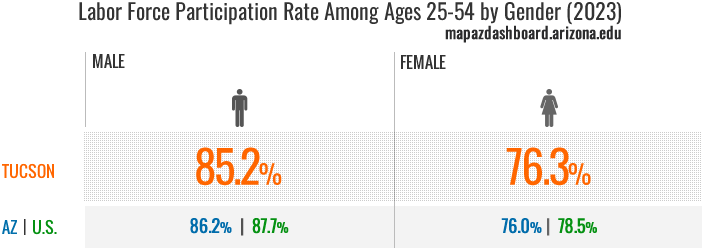 Learn About the Labor Force Participation Rate in Tucson, Arizona MSA
Learn About the Labor Force Participation Rate in Tucson, Arizona MSA
How are we doing?
Labor Force Participation Rate Among Ages 25-54 (2023)

The labor force participation rate in the Tucson Metropolitan Statistical Area (MSA) was 80.8% among adults in their prime working years (ages 25-54) in 2023. Tucson had one of the lowest labor force participation rates compared to peer western MSAs. Denver significantly outpaced the rest with a rate of 87.8%. Arizona’s metro areas rank low among the 12 western MSAs, with Phoenix (82.6%) reporting the seventh lowest labor force participation rate. Out of 12 western MSAs, the six lowest labor force participation rates among adults in their prime working years are located in the Southwest.
Why is it important?
The labor force participation rate is an important gauge of the health and potential output of the economy. As the economy expands, more individuals will be encouraged to enter the labor force – a measure including both employed persons and the unemployed who are actively seeking employment. The demographics of a region can affect this measure significantly. For example, a population with a higher percentage of adults in their prime working years typically will have a higher labor force participation rate and the potential for higher economic growth. Holding these demographic factors constant, a higher labor force participation rate indicates that workers believe businesses are hiring for jobs that are worth their time and effort – valuable information in assessing the labor market in a region.
How do we compare?
For men ages 25-54 in the Tucson MSA, the labor force participation rate was 85.2% in 2023; for females, the rate was 76.3%. Tucson and Arizona both post lower male and female labor force participation rates than the nation. The higher national labor force participation rate among adults in their prime working years reflects a high level of engagement in the labor market across the nation when compared to Arizona.

What are the key trends?
The U.S. economy experienced a long-term increase in the labor force participation rate, largely due to an increase in the percentage of women participating in the workforce during the second half of the 20th century. That trend continued from 2000 through 2023 as the national rate among adults ages 25-54 rose from 79.6% to 83.1%. Arizona experienced a slight decrease in the labor force participation rate among the prime working age between 2009 and 2018 falling from 79.7% to 79.1%, but increased beyond the 2009 rate in 2023. Tucson’s rate has hovered near 80% since 2009. In 2023, the labor force participation rate in Tucson was slightly lower than the state. It appears Tucson did not experience quite as dramatic an impact from the economic boom and bust cycle of the mid-2000s; this may be due in part to the fact that Tucson has a larger share of government-related employment. This sector of the economy is somewhat insulated from the business cycle and typically exhibits more stability during both expansions and recessions.
How is it measured?
The labor force participation rate is calculated by dividing the total number of people in the labor force by the total population. The labor force includes both the employed and the unemployed who are actively seeking work. Data for 2009, 2018, and 2023 are from the American Community Survey (ACS) five-year estimates from the U.S. Census Bureau, while data for the year 2000 are from the U.S. Census 2000 SF3 sample. The ACS is a nationwide rolling sample survey that produces one-year and five-year estimates on demographic, social, housing, and economic measures. Note that the ACS five-year estimates are produced over a five-year time period and can only be compared to non-overlapping five-year estimates (for example 2005-2009 and 2010-2014).












